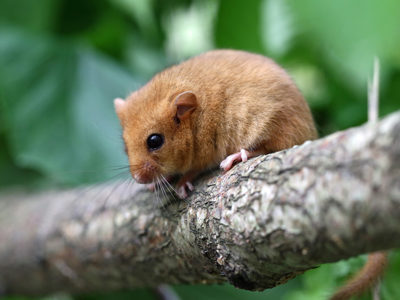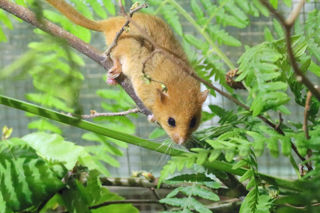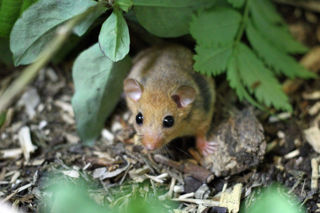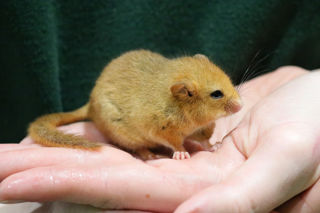
Hazel Dormouse
Muscardinus avellanarius
Key features of the Hazel Dormouse are its completely furred long tail, sandy yellow to orange fur and very large black eyes. Body length ranges from 6-9cm, with the tail being an additional 5-8cm long. Average weights range from 15-22g.

Behaviour
Strictly nocturnal and arboreal species. In summer, nests are built from leaves and shredded bark for dormice to sleep during the day, often in a hollow tree or old bird nest. During the winter however, when food is scarce, dormice hibernate.
Woven nests of vegetation are constructed on the ground, where they will sleep until spring time (April or May). Just before hibernation, fat may comprise of up to half of their body mass, providing crucial energy to keep them alive during the winter months.

UK Status
The UK’s only native dormouse. Mainly found in the southern half of the UK, with strongholds in Devon, Somerset, Sussex and Kent. Numbers and distribution have declined dramatically within the last 100 years; population declined by 50% since 2000.
The hazel dormice is a Biodiversity Action Plan species (BAP); a status that offers protection and conservation plans in order to halt or reverse the decline. It is fully protected by law, and cannot be intentionally killed, injured, or disturbed in its nest. A licence is also needed to trap, handle or collect a dormouse.

Threats
Habitat loss and changes in habitat management are a major cause of decline. Inappropriate woodland and hedgerow management alongside habitat fragmentation has become an increasing problem.
Climate change has also been highlighted, as warm spells during winter can wake dormice up prematurely, when no food is around. Cold springs and wet and windy summers can prevent them from foraging for food. This fluctuating pattern of weather can have long term effects on populations, affecting breeding success.
Distribution
Widespread throughout continental Europe. Also found in northern Asia. This species in on the northern edge of its range in the UK.
Habitat
Woodland, particularly ancient semi-natural hedgerows and scrub.
Diet
Dormice require a succession of food through the year, beginning with tree flowers in spring, followed by insects in summer and nuts and berries in autumn.
Wildwood inside information
Our team of leading experts are helping to breed dormice for the national reintroduction programme. Wildwood also manages the national studbook for the species. For more information on our Hazel dormouse work, visit our conservation page.
Family facts
The dormouse is one of only three British mammal species that hibernates (the other two are bats and hedgehogs). During hibernation, the body temperature falls to that of its surroundings and its heart and breathing rate slow down by 90% or more. It can hibernate from October to May.

